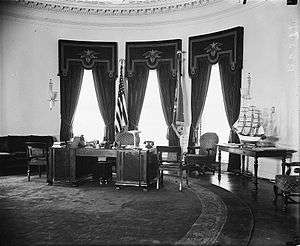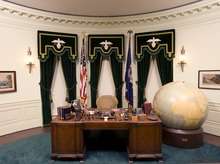Hoover desk

The Hoover desk is a large block front desk, designed by J. Stuart Clingman and built by the Robert W. Irwin Company, used by Presidents Herbert Hoover and Franklin D. Roosevelt in the Oval Office as their Oval Office desk. Created in 1930 as a part of a 17-piece office suite by furniture makers from Grand Rapids, Michigan, it was given to the White House by the Grand Rapids Furniture Manufacturers Association. The Hoover desk is one of only six desks to be used by a President in the Oval Office.
Design and markings

The Hoover desk is a large, 82-inch-wide (210 cm) and 42-inch-deep (110 cm), traditionally designed desk. It was designed by J. Stuart Clingman and was created in the "Royal" plant of the Robert W. Irwin Company.[1] Taking design cues from both Queen Anne and Colonial New England furniture styles, the desk has a block front design motif and has three drawers in each pedestal as well as a center drawer. The desk is made completely of American lumber and faced with Michigan-grown maple burl wood veneer, and finished in a rich French Walnut tone.[1] The desk has an engraved plate attached to it which states: “This desk presented to the President of the United States by the Grand Rapids Furniture Manufacturers Association.[1]
History

At about 8:00 pm on Christmas Eve, 1929, a fire began in the attic of the West Wing. Due to some quick thinking and a tarpaulin, George Akerson managed to save the Theodore Roosevelt desk, but the executive offices were heavily damaged. By 10:30 the fire was extinguished but not before the roof, attic, floors, and press room of the West Wing were ruined. The building was repaired and on April 14, 1930, President Herbert Hoover moved back into the newly constructed Oval Office.[2]
With the opening of the newly repaired and renovated Oval office, Hoover was given a 17-piece office suite, made by furniture makers from Grand Rapids, Michigan, by the Grand Rapids Furniture Manufacturers Association, to furnish the space.[1][3] The Wilson Desk was the centerpiece of this office suite. According to an article in the Grand Rapids Spectator from the time, in addition to the desk the full set consists of a "davenport, a club chair, two large and one smaller wing chairs, two tables, a swivel desk chair, two armchairs, two bookcases, a small table and three smoking stands of two sizes."[1] All pieces have uniform finishes and carry a common design language, but were created by various Grand Rapids furniture manufactures.
When Franklin D. Roosevelt took office after Hoover, he decided to keep the same furnishings and furniture in the Oval Office as his predecessor. Over the course of his presidency he gathered a collection of objects that he displayed on the desk.[3]
After Roosevelt's death, on Harry Truman's first day as President, he cleared off the Hoover desk and shortly thereafter had the desk itself shipped up to what is now the Franklin D. Roosevelt Presidential Library and Museum in Hyde Park, New York.[4] The Hoover desk, the chair Roosevelt used with it, and a selection of objects on the desk at the time of his death are currently on display at the library.[3]
References
- 1 2 3 4 5 "President Hoover's Executive Office Suite". Grand Rapids Spectator. June 28, 1930. Retrieved January 17, 2017.
- ↑ Treese, Joel D.; Phifer, Evan (February 9, 2016). "The Christmas Eve West Wing Fire of 1929". White House Historical Association. Retrieved January 17, 2017.
- 1 2 3 "FDR's Death: FDR's Oval Office Desk". Franklin D. Roosevelt Presidential Library and Museum. Retrieved January 17, 2017.
- ↑ Leuchtenburg, William E. (2015). In the Shadow of FDR: From Harry Truman to Barack Obama. Ithaca, NY: Cornell University Press. p. 13. Retrieved January 18, 2017 – via Google Books.
External links
-
 Media related to Hoover desk at Wikimedia Commons
Media related to Hoover desk at Wikimedia Commons